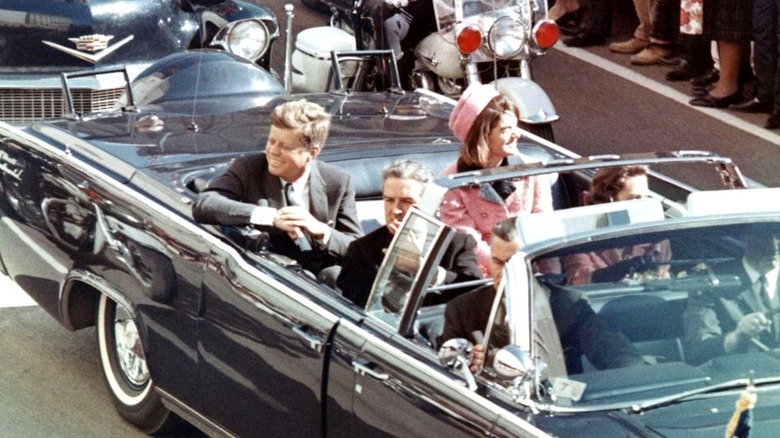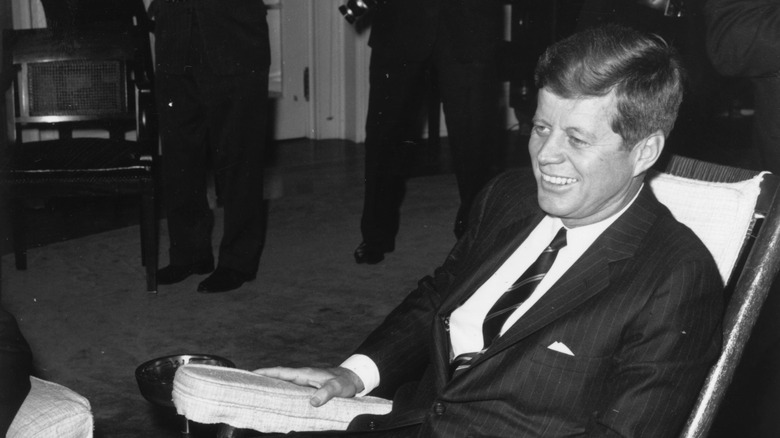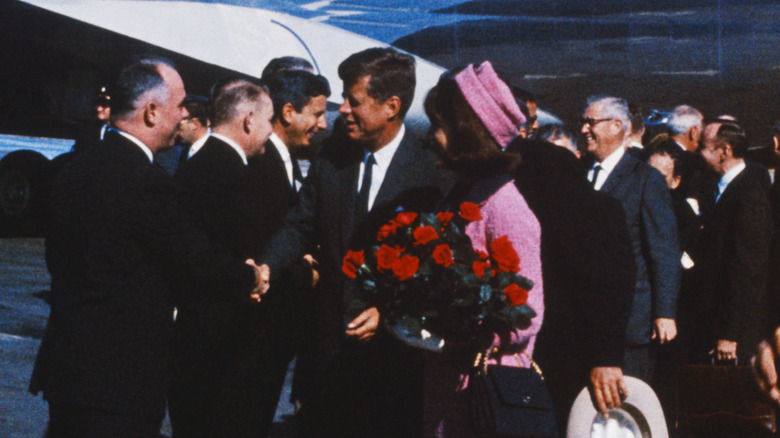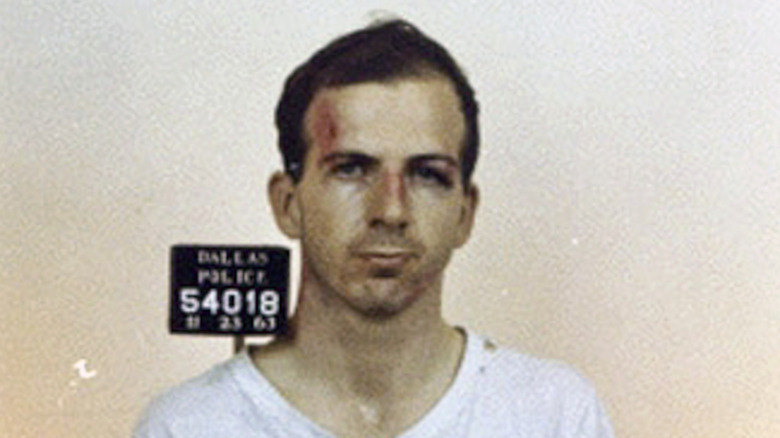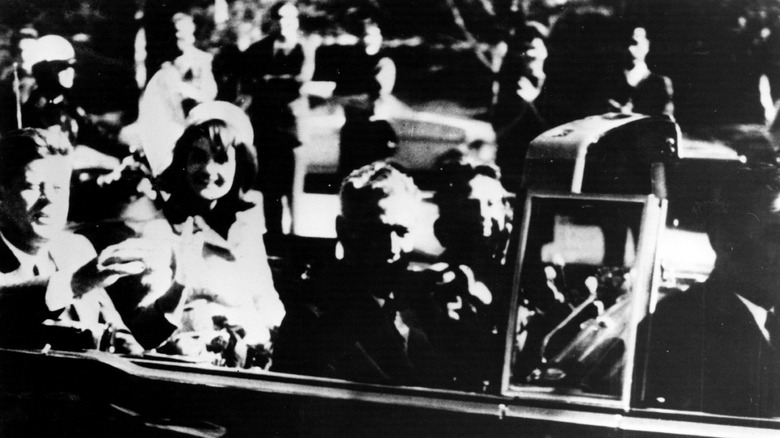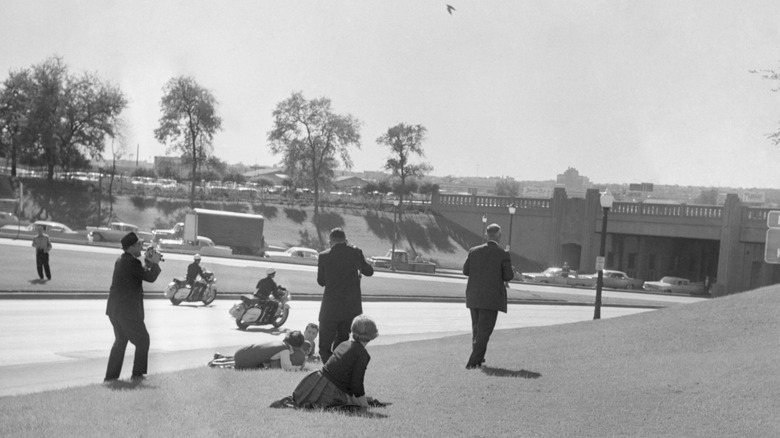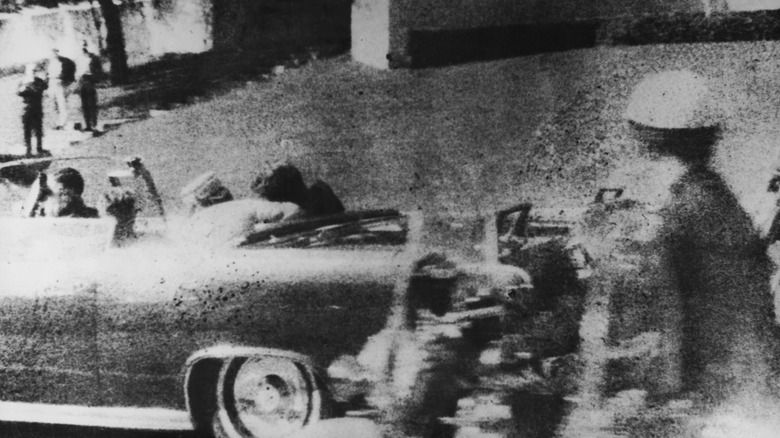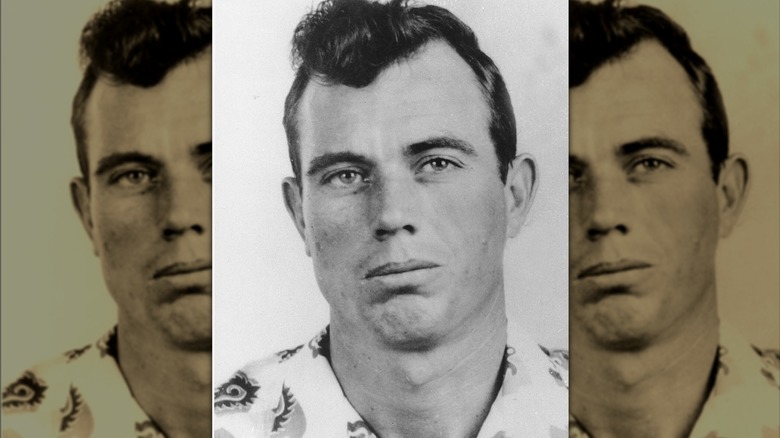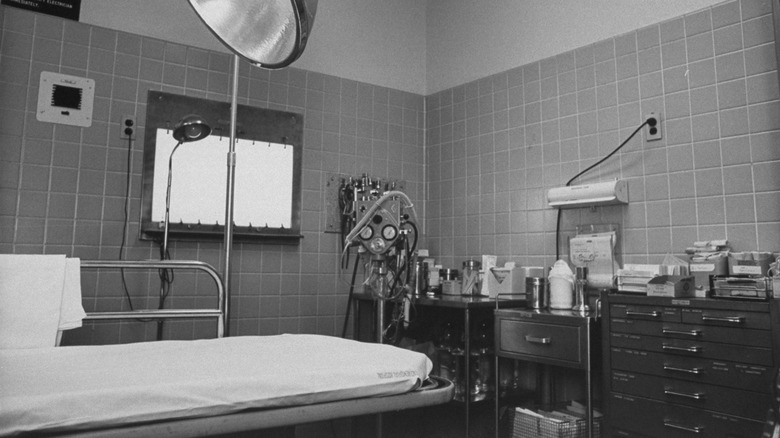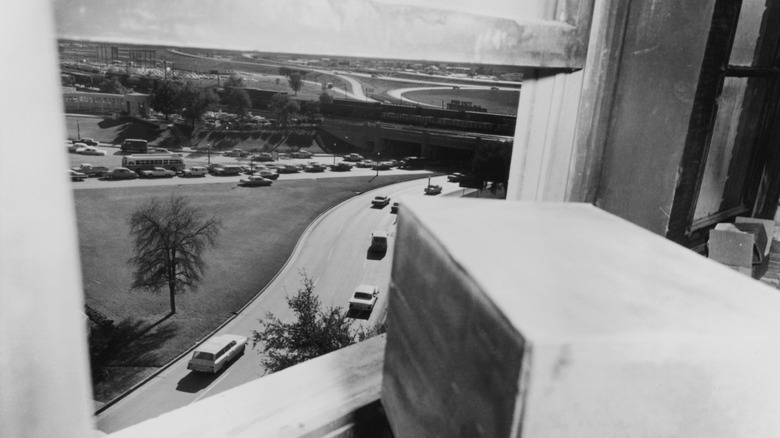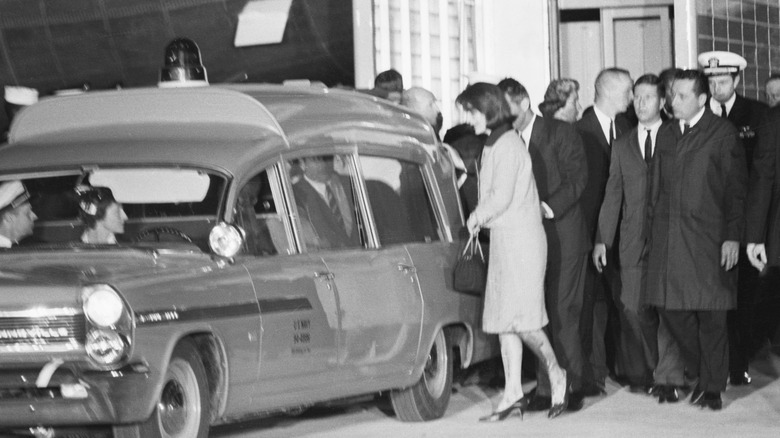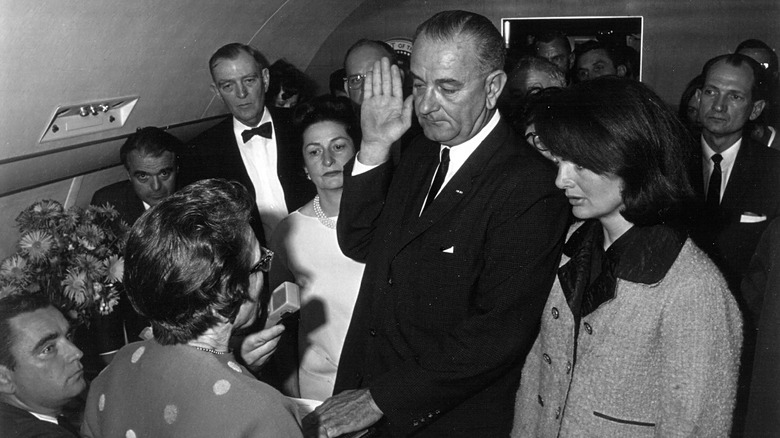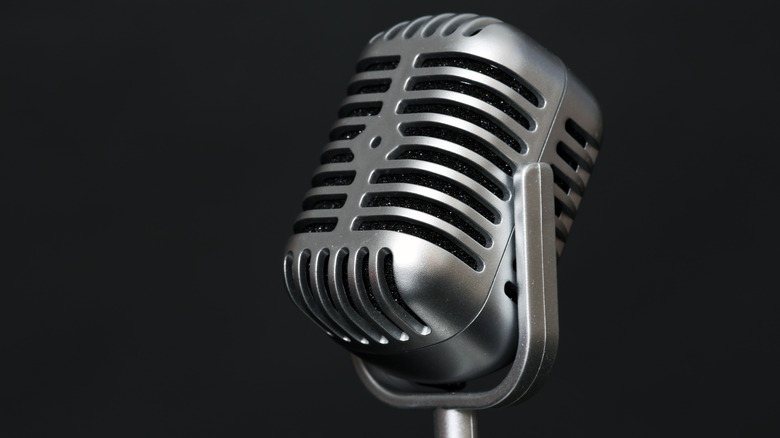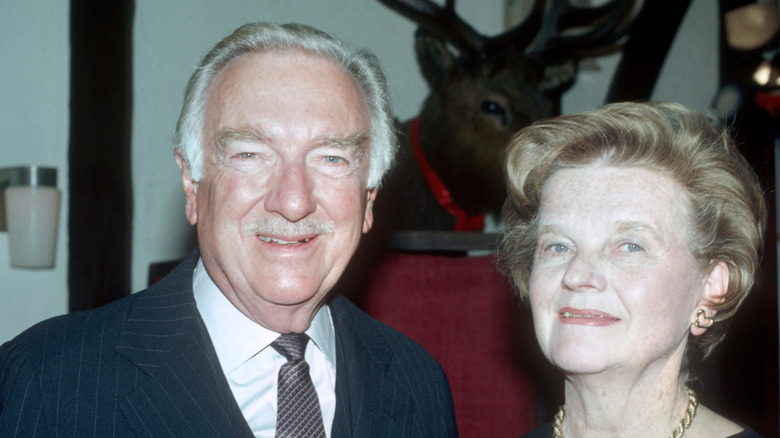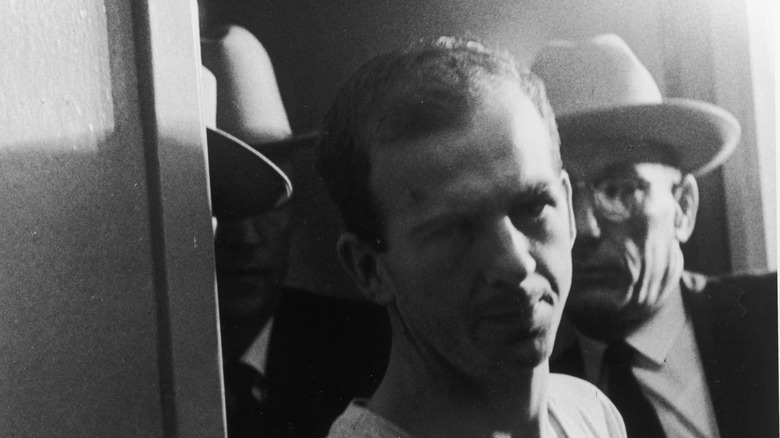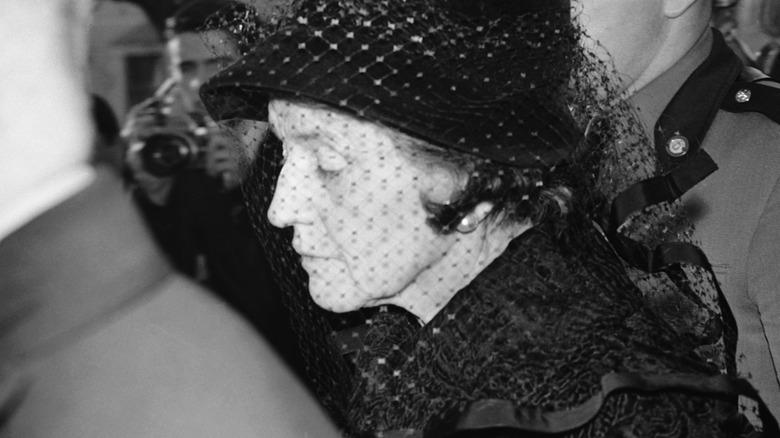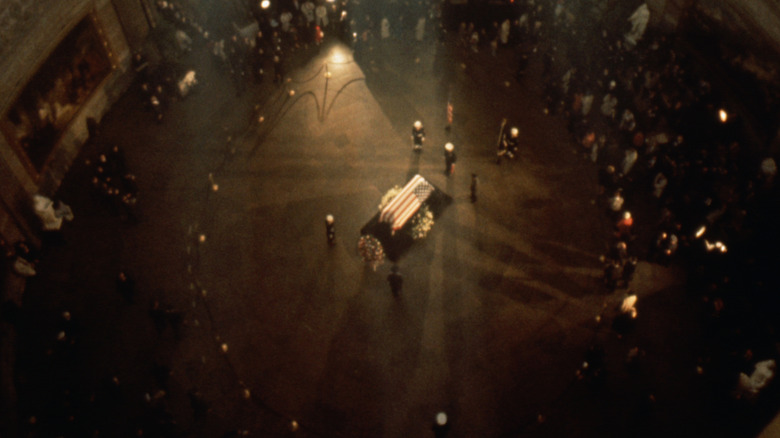What It Was Really Like The Day John F. Kennedy Was Assassinated In 1963
Coming out of the conservative 1950s, the election of John Fitzgerald Kennedy was not so much a turning point in what the country would become as it was a hopeful declaration that the young senator from Massachusetts could navigate the troubling waters on the horizon. Kennedy stood in direct contrast to his predecessor, the conservative former war general Dwight D. Eisenhower.
In office, President Kennedy faced the early stages of many major conflicts that would eventually explode by the middle and end of the decade: the war in Vietnam, the Civil Rights Movement, and denuclearization. All these issues and more had been building during the previous decade and finally burst open in the 1960s, at which point the Kennedy Administration no longer kicked the can down the road and instead opted to face these issues head-on.
After three years, President Kennedy hoped to gain enough support to be elected to a second term. He traveled to Texas on November 22, 1963, hoping to strengthen his standing in the Lone Star State. He left in a casket. JFK's assassination was a watershed moment in United States history. Here is what it was really like the day John F. Kennedy was assassinated.
Arriving in Fort Worth
The last 12 months of John F. Kennedy's life had been busy enough serving as president, and in November 1963, he was beginning to campaign for the 1964 election. Kennedy planned a five-city trip across two days in the Lone Star State. With the help of former Texas senator and his vice president Lyndon B. Johnson, Kennedy was able to win Texas in a close 1960 election. However, disarray within the Texas Democratic Party from JFK's policies prompted a trip to make sure Texas stayed blue in 1964.
President Kennedy and first lady Jacqueline "Jackie" Kennedy arrived in Fort Worth, where he delivered a speech at a breakfast at the Chamber of Commerce. Landing in the morning to a crowd of thousands in the rain, President Kennedy gave an unplanned speech to the crowd before departing for the planned breakfast.
Jeb Byrne, a political appointee working in the General Services Administration since Kennedy took office, was sent ahead to make the preparations for the Fort Worth breakfast. He wrote in 2000 (via the National Archives) that the White House had questioned the trip's effectiveness altogether because of the disconnect between the Kennedy Administration and Texas' Democratic Party: "The animosity between Senator Ralph W. Yarborough and the state's two other leading Democrats, Gov. John B. Connally and Vice President Johnson, was well known. But Kennedy decided to make the trip despite any misgivings he had about factionalism."
Still, the Chamber of Commerce breakfast went off without a hitch, and Kennedy spoke about the nation's future. It would be his final speech.
Arriving in Dallas
After giving his breakfast speech in Fort Worth, both the president and first lady boarded Air Force One at 11:30 a.m. The flight lasted less than 10 minutes, and the couple landed at Love Field in Dallas to swarms of cheering supporters. The rain stopped around this time, and the transparent bubble top on the limousine was removed for the 10-mile trip that would take the president through downtown Dallas, a decision that would prove to be a fatal mistake.
Upon exiting Air Force One, the Kennedys were greeted by Democratic Texas governor John Connally and his wife Nellie. The two couples would ride together in the motorcade through downtown Dallas, departing Love Field at 11:55 a.m.
In spite of the roaring crowds that seemed to follow the Kennedys throughout Fort Worth and Dallas, there was a strong anti-Kennedy sentiment in the state as well. The day prior to Kennedy's arrival in Texas, anti-Kennedy flyers appeared in the city, as well as a paid right-wing advertisement in the Dallas Morning News attacking JFK. Governor Connally himself was a controversial figure in Texas and in the state's Democratic Party. His alliance with Lyndon Johnson during their rise in Texas politics in the previous decade had left a bad taste in many Democrats' mouths. Still, no one expected what would happen about half an hour later.
Jackie Kennedy was already mourning a tragic loss
Photos of John F. Kennedy and his wife Jackie Kennedy getting off the plane in Dallas and greeting well-wishers give no indication that it was anything but another day in the life of America's first family. Behind those smiles, though, was a devastating loss. In August, Jackie had gone into premature labor and their son, Patrick Bouvier Kennedy, died at just 2 days old. Jackie retreated to mourn in private, and those who knew the couple best say that their relationship grew stronger as they supported each other through the grief.
White House correspondent Sid Davis described in the documentary "JFK: One Day in America" (via People) what was going on that day, as John and Jackie moved through the crowds and made their way to that fateful motorcade. "She was getting over [Patrick's death]. This was her first visit out of the White House, in the public, and so it was an uplifting thing for people to see her out and smiling," he said. The couple were in Fort Worth for breakfast on the day of the assassination, and Davis recalled the moment Jackie joined them: "When she walked into the room, the crowd just got out of its chairs and started cheering. I'd never seen her happier than she was that morning."
The atmosphere was one of optimism, strength, perseverance, and determination in the face of insurmountable tragedy. Friends later spoke of how much Jackie had been looking forward to the trip, and how she was finally feeling as though they would get through it all — together.
Lee Harvey Oswald's morning
The morning of November 22, 1963, was just like any other for Lee Harvey Oswald, at least in comparison to the past few years of his life. In the first three months of the year, Oswald bought two guns: a .38 revolver and a rifle with a telescopic sight. On April 10, Oswald attempted to assassinate a far-right former army general, Edwin A. Walker. Later that month, Oswald moved to New Orleans with a friend to voice their support of Fidel Castro, Cuba's communist leader, and attempt to obtain a visa to move to the island nation.
Oswald had tried to become a citizen of the USSR shortly after leaving the U.S. Marines in the autumn of 1959. During his two and a half years in the Soviet Union, Oswald married a woman named Marina Nikolayevna Prusakova and had a daughter named June Lee before returning to the U.S. in June 1962. Oswald retained a desire to return to the Soviet Union, though this would fail as well.
Oswald obtained a job at the Texas School Book Depository as an "order filler" in October 1963. He primarily worked on the first and sixth floors of the building. On November 22, Oswald carpooled to work with a neighbor, Buell Wesley Frazier. He placed a large brown bag in the backseat of Frazier's car, telling Frazier they were curtain rods.
The shots are fired
A bit after noon on November 22, 1963, the U.S. and world would change forever. Around 150,000 people stood along the 10 miles between Love Field and the Dallas Trade Mart to see the first lady and President Kennedy. In the car with them were Governor John Connally and his wife, Nellie.
The first couple made their way onto Main Street at 12:21 p.m. At 12:30 p.m., as the motorcade passed by the Texas School Book Depository, three shots were fired from a sixth-floor window. Two of the three shots hit both President Kennedy and Governor Connally. As the motorcade sped away from the scene, JFK crumpled against Jackie Kennedy.
In an interview years later, U.S. Secret Service agent Clint Hill discussed the events. He said that President Kennedy had requested that the Secret Service not surround the vehicle, as he did not want there to be any separation between him and the people. So as a precaution, the driver drove away from the right side of the street, where President Kennedy was seated. Because of this, Hill was more attentive to first lady Jackie Kennedy, as she was closer to the crowd, which presented a more realistic threat as the large number of supporters filled the sidewalks and moved onto the street.
A bystander was also injured in the assassination
There was one other person who was hit by a bullet in Dallas that day. James Tague was on his way to pick up his girlfriend for lunch when he found himself in Dealey Plaza as gunshots rang out, and he later told NBC what that moment was like. After hearing what he thought was a firecracker, he described those next moments: "Two rifle shots, not a second apart, and something stings me in the face. It could've been a mixture of a little bit of lead and concrete. I was sprayed. Debris hit me in the face. Broke the skin in maybe three or four places. A drop of blood in each place. Nothing serious."
What Tague had initially assumed was no big deal turned out to be a very big deal, indeed. Originally, it was believed that Kennedy had been hit by two bullets and Connally by a third, but with Tague's testimony, that needed to be rewritten: he had been hit with debris from the third bullet.
Tague took cover. When the shooting didn't continue, he got ready to leave. Before he could, though, he was approached by a deputy sheriff, asked what happened, and the two backtracked to the broken curb. Tague was in the middle of giving a statement that changed the course of the Kennedy assassination when he saw Lee Harvey Oswald escorted into the Dallas police station, and only learned that night who, exactly, had walked in front of him.
The immediate reaction
As the motorcade desperately rode off to nearby Parkland Memorial Hospital to save both President Kennedy and Governor Connally, Lee Harvey Oswald quickly began to make his way out of the Texas School Book Depository, but he was immediately stopped by two officers. The officers, Merriam Baker and Roy Truly, recognized Oswald as an employee and released him, not suspecting he was the triggerman.
On the ground, the once-jubilant witnesses of JFK's assassination were left in a state of horror, confusion, and anxiety. James T. Tague, who was standing on the triple underpass, spoke about the day to ABC News. "I wondered what had just happened and a man in a suit who turned out to be a deputy sheriff in plain clothes ran up and asked what had happened," he recalled. "Across the street people were sobbing, 'His head exploded.' The policeman said 'Whose head?' It was the president's."
Another witness even closer to JFK was the second lady, Lady Bird Johnson, who was riding in a car behind the president. In an audio diary from the National Archives, Lady Bird had this to say about her immediate reaction to the gunshots: "There had been such a gala air that I thought it must be firecrackers or some sort of celebration. Then in the lead car, the Secret Service men were suddenly down. I heard over the radio system, 'Let's get out of here.'"
A Dallas police officer was shot and killed during the search for Lee Harvey Oswald
The search for John F. Kennedy's assassin kicked off immediately, and that search wasn't entirely blind. A description of Lee Harvey Oswald was given to officers in the city, and just 45 minutes after the Dealey Plaza shooting, a man matching the issued description was spotted by Dallas patrol officers. Officer J.D. Tippit (pictured) questioned a man matching that description, and when he was suspicious enough to leave his patrol car, he was shot four times and killed.
Witnesses saw the fatal shooting, with one calling for help on Tippit's car radio. Even as law enforcement responded, Johnny Calvin Brewer — the manager of a nearby shoe store — heard the updates and, in what had to be a shocking turn of events, saw the suspect walk into his store. When he left, Brewer followed: In 2011, he was honored with the Citizen's Certificate of Merit for following Oswald to a nearby theater and directing police to the suspect.
Tippit's partner, R.C. Nelson, was among those who arrested Oswald at the Texas Theater and was assigned to Oswald's protection detail. (He would later arrest Jack Ruby for Oswald's death.) After years of silence, Nelson spoke with CBS in 2013, saying, "I have to believe Lee Harvey Oswald flagged Tippit down. Oswald had not had his glory." For Nelson, November 22, 1963, came to a close as he sat in a local park, alone, and cried.
A medical student was one of the first to see JFK at Parkland
After John F. Kennedy was shot in Dallas's Dealey Plaza, they didn't have far to go to find medical care: Parkland Memorial Hospital was about 4 miles away, and they arrived at 12:38 p.m. One of the first to see him was a third-year medical student named Lawrence Klein. It was Klein who escorted the president into Trauma Room One, and who paged other doctors, many of whom were unaware of what was going on.
Parkland is associated with the medical college at the University of Texas Southwestern. That meant there were many medical students there, including Jed Rosenthal. He remembered walking past the president's car and seeing the red roses that Jackie Kennedy had been holding — still in a bouquet — in the back. Others spoke of seeing Jackie around in the emergency room, and as one team tended the injured Governor John Connally, another hooked JFK up to an EKG meter. There was no reading.
It was W. Kemp Clark, MD and head of neurosurgery, who determined that the head wound was fatal, and Jackie requested a delay in declaring a time of death. Surgical Chief Resident Ronald Coy Jones, MD, would later say (via UT Southwestern Medical Center): "At that point, Mrs. Kennedy said she didn't want the president pronounced dead until a priest arrived. She was almost always with us, only feet away from her husband." Twenty-two minutes after arriving at the hospital, he was pronounced dead.
The race to save Kennedy and find Oswald
At 12:45 p.m., Dan Rather of CBS called Parkland Memorial Hospital and was told by a doctor that he believed Kennedy was dead. At 12:58 p.m., Father Oscar Huber arrived at Parkland Memorial Hospital to give JFK his last rites. Two minutes after the priest's arrival, at the time President Kennedy was supposed to give a speech at the Dallas Trade Mart, he was pronounced dead. Between 1 p.m. and 2 p.m., the country received the earliest reports that President Kennedy had been shot in Dallas.
Meanwhile, Lee Harvey Oswald attempted to evade the law enforcement officers mobilized to find the shooter of the president and governor. Oswald had left the rifle on the sixth floor and returned home to obtain his pistol. Between 1:12 p.m. and 1:22 p.m., Oswald's rifle and the empty round shells were discovered on the sixth floor of the Book Depository, and Oswald fatally shot Dallas officer J.D. Tippit. While the press continued to hound the Parkland staff about news of Kennedy's health and people in his administration learned about their boss' death, Oswald would sneak into the Texas Theatre in Oak Cliff, where he would be arrested at 1:50 p.m.
Jackie Kennedy refused to change out of her blood-stained clothes
Few outfits are as instantly recognizable as the pink Chanel suit that Jackie Kennedy was wearing when John F. Kennedy was assassinated. Jackie was not only wearing it when he was shot, but she refused to change until she was back at the White House — at around 4 a.m. on November 23. John had chosen the suit for the trip, saying it was the perfect mix of simple, classy, and stylish.
When she returned to Air Force One after the shooting, she washed blood from her face. In a later interview with Life, she would say (via Biography), "One second later, I thought, 'Why did I wash the blood off?' I should have left it there; let them see what they've done." That was the motivation for refusing to change into the clothes that had been prepared for her, and it was also the reason she allowed photographs of her. Historian Steve Gillion explained to People just what those moments and imagery meant: "Despite these horrible circumstances, she was willing to stand for a photo because she understood what it meant for the nation to have continuity in government. She understood that she had a role to play in helping the nation transition to a new president."
Today, the pink suit remains at the National Archives. Instructions from the Kennedy family specify that it not be displayed until at least 2103, and that's only if permissions are granted.
LBJ After Kennedy's Death
In spite of the chaos and tragedy of the early afternoon, Vice President Lyndon Johnson was sworn in as president of the United States 99 minutes after the pronouncement of Kennedy's death. With him were the newly widowed Jacqueline Kennedy and the new first lady, Lady Bird Johnson.
Lady Bird recalled the car ride to the hospital immediately following the shooting (via the National Archives): "[Secret Service agent] Rufus Youngblood vaulted over the front seat on top of Lyndon, threw him to the floor and said, 'Get Down.' Senator Yarborough and I ducked our heads. The car accelerated terrifically fast ... We pulled up to a building. I looked up and saw it said 'Hospital.'" She and the other passengers were moved into a room protected by the Secret Service. Despite the confusion of the situation, Lady Bird recalled her husband remaining calm and asking her to check on Jackie Kennedy and Nellie Connally, who had been a family friend since the late 1930s.
As soon as Johnson learned of Kennedy's death, he left the hospital and made his way to Air Force One, no longer feeling safe in the city. Despite being made commander-in-chief as soon as Kennedy died, Johnson decided to take the oath of office on Air Force One with Jackie and Lady Bird by his side to show the nation a sense of cohesion and unity.
Local news announces that Kennedy has been shot
In the age of social media, news of an assassination attempt on the POTUS would be known in seconds. That being said, the shooting of John F. Kennedy was reported throughout Texas and the rest of the nation within minutes.
Locally, there was no bigger story than President Kennedy arriving and speaking in Dallas, so a number of reporters were assigned to cover JFK. According to ABC News, one of those reporters was KLIF's Gary DeLaune. The radio anchor was supposed to cover Kennedy's speech at the Dallas Trade Mart. He recalled the moment he learned about the shooting: "I had finished my morning runs on the news side and did the sports and was in the studio. At about 12:36, I received an anonymous phone call: 'What did I know about shots fired and Kennedy and Connally hit?'"
Once it was confirmed with the Dallas police that bullets had been fired and hit the president and governor, KLIF broke the news. As local news began to report on the story within the state, national news outlets relayed it for the nation to hear.
National news announcements of Kennedy's death
Ten minutes after the shooting occurred, CBS' Walter Cronkite gave the first national bulletin that the president had been shot. Just five minutes later, Dan Rather got the news that President Kennedy was believed to be dead from a doctor in Parkland Memorial Hospital. Still, it would be just under an hour until this would be confirmed and an announcement about Kennedy's death made. In the almost hour between, the nation was desperate for any news they could.
Eddie Barker, a local Dallas reporter working with CBS, was the first reporter to announce the death of President Kennedy. Barker would go on to be the first reporter to interview Oswald's wife, Marina. Minutes after Barker's reporting, Walter Cronkite announced on CBS to the nation that President Kennedy had been pronounced dead.
Dan Rather, a Texas native and reporter for CBS at the time, was in Dallas. He recalled his immediate reaction after learning of Kennedy's death to CBS News: "After the initial hammer to the heart that an assassination of the president, the reality of that sinks in, then it was 'focus on the story.' Because if you don't do that, then you're at some risk of just falling apart emotionally."
Bobby Kennedy's November 22
President Kennedy did not have a closer ally in his political life than that of his younger brother, Attorney General Robert F. Kennedy. On November 20, Bobby Kennedy was celebrating his 38th birthday with his family. People close to the younger Kennedy noticed he was in a cold mood, as he was intensely focused on getting his brother reelected. On November 22, while having lunch, he received a phone call from FBI director J. Edgar Hoover, who told him that his brother had been shot.
Hoover and the Kennedys were not close, and Bobby remembered Hoover having no emotion while delivering the news that the president had been shot. As Bobby's wife, Ethel Kennedy, comforted her distraught husband, Bobby could only think about how he believed he should have been the one to be targeted, not his brother. Bobby was his brother's protector both before and during his time as president and had a reputation as a fighter, which stood in stark contrast to the cool and elegant JFK. Bobby's mind raced, wondering if his push to go after the mob, the Soviets, or the Castro regime had led to his brother being targeted.
After learning of his brother's death, Bobby made his way to Washington to comfort his sister-in-law, Jackie Kennedy. But before that, he spoke to CIA director John McCone and inquired if the agency had been responsible for Kennedy's assassination. McCone denied any involvement in the assassination.
Interrogating Lee Harvey Oswald
After he was captured, the rest of Lee Harvey Oswald's day on November 22 was spent being processed and interrogated by police and federal agents. In fact, Oswald spent the rest of his life in the headquarters of the Dallas Police Department, as the National Archives details. However, Oswald was originally picked up not for Kennedy's assassination, but for the death of Officer J.D. Tippit.
Dallas homicide detective Jim Leavelle recalled interviewing Oswald and receiving a suspicious answer when he asked if he had shot the policeman: "He said, 'I didn't shoot anybody.' Well I thought it was a little strange in a way because I had worked two other police officer murders and usually, they would say, 'I didn't shoot the policeman' or 'I didn't shoot the cop."
Oswald would eventually be charged and interrogated for both the murders of President Kennedy and Officer Tippit. Leavelle was handcuffed to Oswald as he was being transferred to jail two days later. No other person was closer to Oswald when he was fatally shot by Jack Ruby than Leavelle.
Returning to Washington, D.C.
According to Esquire, the newly inaugurated President Johnson gave his first order as commander-in-chief at 2:41 p.m. "Now, let's get airborne," he said, desiring to return to the nation's capital. Six minutes later, Air Force One was making its way back to Washington, D.C., with the body of John F. Kennedy on board and Jackie Kennedy standing close to it.
There had been well-documented friction between the Kennedys and Johnson, but in this critical time, that dynamic was utterly changed. During the plane ride, Johnson spoke to the matriarch of the Kennedy family, Rose, and talked to Ken O'Donnell, Kennedy's special assistant, about his services in the new Johnson administration. "I need you more than he ever needed you. You can't leave me," Johnson said. "You know that I don't know one soul north of the Mason-Dixon Line, and I don't know any of those big-city fellows. I need you."
The plane arrived at 5:58 p.m. local time. As the ramp came down on the tarmac in the dark of the night and among the media, A.G. Bobby Kennedy quickly made his way into the plane. He ignored President Johnson and other passengers, looking for Jackie Kennedy. Upon seeing her brother-in-law, the former first lady fell into his arms.
JFK's mother was notified of his death
Hashing out a timeline of the assassination of John F. Kennedy is understandably difficult, and it wasn't until 2012 that a newly released version of a 142-minute recording, made on the flight from Dallas to Washington, D.C., truly painted a picture of how chaotic and difficult things were. One of the conversations that's heard on the tape is between now-President Lyndon B. Johnson and John F. Kennedy's mother, Rose Kennedy.
Johnson can be heard saying, (via the Independent), "I wish to God there was something that I could do, and I wanted to tell you that we are grieving with you." Rose Kennedy gave her thanks before ending the call, and in a 1973 interview with the BBC, she said that when she had first heard the news, she had hoped for the best.
"I'm an optimist. When I first heard it, I thought maybe it was just an accident, or a slight ... slight sort of thing," she said. "But then Bobby [Robert Kennedy] telephoned and said it was serious, and then events moved very quickly." She was at her Hyannisport home when she heard, and in another 1973 interview, she revealed that she headed to the beach and walked. There, she tried to battle the grief and come to terms with the knowledge that not only had she lost another child, but that she would need to be a source of strength for her family — and the nation — in the days ahead.
JFK's autopsy was done the same day he was killed
There were a number of disturbing details found in the autopsy report of John F. Kennedy, and perhaps surprisingly, that autopsy was done on the same day that he was assassinated. The flight that carried Kennedy's body, his wife, and America's new president landed at Andrews Air Force Base, and at around 8 p.m., doctors at Bethesda Naval Hospital began their autopsy. The findings were seemingly straightforward: The president had been hit by two bullets, and killed by the one that had entered his skull.
Just what went on during the autopsy has been the subject of considerable debate, especially with accusations that it wasn't properly carried out. One of the doctors who had been part of the autopsy was James Joseph Humes, and it wasn't until 1996 that Humes revealed that after the autopsy was completed, he had taken documents home. Horrified by the fact that they were covered with blood, Humes said he copied the documents before burning the originals.
There have also been questions raised about whether or not proper autopsy procedures were followed, and there were also concerns raised about the authenticity of the official photos. One of the forensic pathologists later asked to review the autopsy photos and documents was Werner Spitz, who spoke with USA Today about what he saw as grievous errors — including the burning of the documents — and added, "When people are on the autopsy table, they are all the same."
